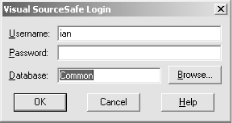If you would like to add a solution
to a source control database, you can do so from within Visual Studio
.NET using the File  Source Control menu. This menu
presents two options with which you can add items to source control.
"Add solution to source control"
allows you to connect to a source control database and add the entire
solution, including all the projects and files it contains, to that
database. "Add selected projects to source control" allows you to add only projects that are
currently selected in the Solution Explorer.
Source Control menu. This menu
presents two options with which you can add items to source control.
"Add solution to source control"
allows you to connect to a source control database and add the entire
solution, including all the projects and files it contains, to that
database. "Add selected projects to source control" allows you to add only projects that are
currently selected in the Solution Explorer.
If you select either of these options, you will be presented with the
Visual SourceSafe Login dialog box, as shown in Figure D-2.

If you wanted to connect to a different database than the one
displayed, you can select the Browse button and browse to the
directory that contains the database to which you would like to
connect.
 |
The first time you use source control in any VS.NET session,
SourceSafe needs to log you in to the database. In general, it will
try to do this automatically so that you don't need
to see the login boxif there is a VSS account with the same
name as your Windows account, it will normally log in with that name.
(If you use this approach, do not make the passwords the same! VSS
password security is weak to the point of being optionalfor
this style of automated login, you will never be prompted for your
VSS password. You are better off leaving your VSS password blank and
using Windows security to protect the database files, as described in
VSS Help.)
However, in certain circumstances VS.NET will not log you in
automatically, for example, when you add a solution to source control
or use the File  Source Control Source Control  Open From Source Control... menu option. The reason for this is that
the login dialog not only asks you for your credentials but also
allows you to choose which VSS database to use. When adding new
projects or retrieving projects for the first time on a given
machine, it is important to be able to specify which database to use.
VS.NET therefore always shows the login dialog in these
circumstances. But when you open a local copy of a file that is
source controlled, VS.NET logs in silently if it can. (Of course, if
your VSS login name is different from your Windows name, you will
always get the login prompt.)
Open From Source Control... menu option. The reason for this is that
the login dialog not only asks you for your credentials but also
allows you to choose which VSS database to use. When adding new
projects or retrieving projects for the first time on a given
machine, it is important to be able to specify which database to use.
VS.NET therefore always shows the login dialog in these
circumstances. But when you open a local copy of a file that is
source controlled, VS.NET logs in silently if it can. (Of course, if
your VSS login name is different from your Windows name, you will
always get the login prompt.)
|
|
Once you connect, a dialog allowing you to select where your solution
will go in the SourceSafe database's hierarchy will
appear. If you just press Enter, you will get a dialog asking if you
want to create a project with the name of your
solution. The term project means something quite different to
SourceSafe than it does to VS.NET; in fact, a VSS project is most
closely related to a solution in VS.NET (and VSS
doesn't really have a direct equivalent of a VS.NET
project). When you add a solution to a VSS database, it becomes a VSS
project, and all of the VS.NET projects and files in the solution
will be added to the new VSS project.
If you accept the default location, your VSS project will be created
at the root of the VSS database you have connected to. (Otherwise, it
will be created wherever you told VSS to create it.) Once you have
added your solution, the nodes in the Solution Explorer add icons
next to them to indicate their source control status. When you first
add a solution, all of the files will be checked in, so every file
will have a small lock icon, as Figure D-3 shows.












